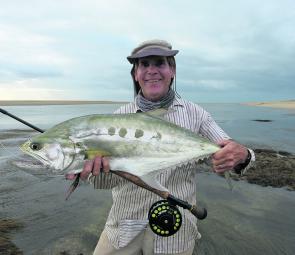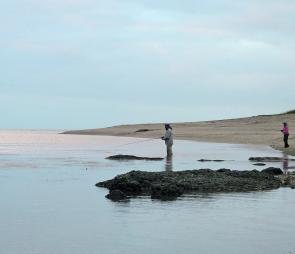It was a long standing ambition of mine to catch a queenfish on the long rod. Every video and DVD I avidly watched always portrayed these fish as tremendous fighters, and I was jealous of the anglers holding their fish for display.
Queenfish, however, have always been a bit mystical for a South Queensland fly angler like myself. I always though I’d need to go a long way up north to catch one, but I was wrong. I caught my first one in a Gold Coast waterway while fishing for other species on fly, and I caught another in a suburban canal system in the Redlands area. These fish were little tackers of around 45cm, spikey as all get out, and an obviously different fish from those in the tropical and sub-tropical waters of our east coast. The obvious differences with these local so-called ‘oceanic’ fish was the nasty array of dorsal spines plus a lack of spots on their sides, whereas the northern queenfish have distinct spots, are a bit less spiky, and commonly grow to more than a metre long.
Given their ability to jump and carry on once hooked, queenfish are a great sportfish and very popular with anglers of all persuasions. A look at a queenie reveals a deep but somewhat skinny fish with big eyes and a wide mouth, sporting an array of teeth in an underslung lower jaw. The big mouth looks almost comical, but if you were a baitfish with a queenie on your tail I doubt you’d see anything funny about that mouth!
Larger queenies always seem to exhibit four dark spots on their flanks. Their long but thin body is equipped with a deeply forked tail built for fast work on bait, and even faster work to escape from predators.
Where do we find them? Around the coast of Cape York and the western side of the Gulf, queenies are common enough to be almost annoying. However, as you go further south they become somewhat patchy; a fish will frequent one area and leave others well alone for some reason. And in the more southern areas they are quite seasonal, turning up regularly in a particular locality and then moving on as a season advances.
Unlike some other desirable fly rod targets such as tuna and mackerel, queenfish are obliging enough to be regularly seen working bait around steeper shorelines, sand spits, break walls, headlands and the like. In areas where they are common, a shore-based angler should have plenty of opportunities. These fish often feed right into the shallows. I’ve actually seen baitfish jumping up on the sand to escape marauding queenies, which proves these predators will certainly move in close enough for a fly angler to get at them.
Although queenfish have a wide range along the coast, I really recommend fishing for them in the far north where they’re most plentiful. If you’re thinking about making a trip up north, here are some hints for targeting these speedsters.
One of the really interesting features of these large-mouthed fish is their manner of feeding, which is different from the way tuna and mackerel feed. It’s easy to tell when tuna are feeding on balled-up bait, as they jump a little and usually show their tails or backs as they roll into the melee. Mackerel do much the same as far as balling-up bait goes, but they slash and rip the surface in a manner distinctly different from tuna. It’s usual to see flocks of birds working along with both tuna and mackerel when surface feeding.
Queenfish are different. When queenies are working the surface there’s often a big flat splash, quite out of proportion to the size of the fish making it, with the next visible attack often some distance away. There may be bird or two in attendance but seldom a big flock. This is because queenies tend not to round up bait at all, instead using hit-and-run tactics to quickly snatch baitfish at random. This is particularly true in the case of the larger fish, the ones we flyfishers like to engage. That big chop or massive swirl you can see isn’t where the fish is. It’s where he has been.
The key to success is to give a feeding fish a fair amount of lead, get the fly as close as possible into its projected path, and then retrieve the fly at best speed. While queenies are only too willing to take a fly, they must see it first. That means the closer the better.
Most small baitfish-style wet flies will be taken readily, and poppers are also very good. If a popper is making some disturbance not far from a working queenie it won’t be long before it’s taken. The only drawback with poppers is some restriction in casting distance due to their air resistance when compared to slim wet flies.
Fly tackle should be robust. These fish are often a metre or more in length, and a fish of that size can give a rod and reel – and the angler – a decent workout. An 8wt outfit is ideal most of the time. A 9wt or 10wt is required only where it’s almost certain that there’s a run of larger fish.
Your reel must be set up with a smooth drag and have at least 100m of backing behind the fly line: an intermediate sink rate line is fine for wet flies, a floating line being the alternative for use with poppers. A 10kg leader tippet should guard against bite-offs if a fish takes a fly deep.
Queenies take the fly with a heavy jolt followed immediately by a scorching run and often a series of quick action tail-walking jumps, which can dislodge the fly. The clue is to hook up as the line jars tight with a strip-strike and then keep the rod low and to the side to discourage those crazy jumping tactics. Most queenies are good for at least two decent runs before they begin to tire.
These fish are actually not bad eating if bled and then kept on ice, but fresh is definitely best. They are great in a curry or as numus. Not familiar with numus? Do a Google search for the NT Government recipe, it’s delicious.
Reads: 5135







